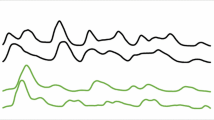Abstract
The concern of this work is the identification of the (nonlinear) system of a neuron firing under the influence of a continuous input in one case, and firing under the influence of two other neurons in a second case. In the first case, suppose that the data consist of sample values Xt, Yt, t=0, ±1, ±2, ... with Yt=1 if the neuron fires in the time interval t to t+1 and Yt=0 otherwise, and with Xt denoting the (sampled) noise value at time t. Suppose that Ht denotes the history of the process to time t. Then, in this case the model fit has the form
where
where γ t denotes the time elapsed since the neuron last fired and ϕ denotes the normal cumulative. This model corresponds to quadratic summation of the stimulus followed by a random threshold device. In the second case, a network of three neurons is studied and it is supposed that
with Xt and Zt zero-one series corresponding to the firing times of the two other neurons. The models are fit by the method of maximum likelihood toAplysia californica data collected in the laboratory of Professor J.P. Segundo. The paper also contains some general comments of the advantages of the maximum likelihood method for the identification of nonlinear systems.
Similar content being viewed by others
References
Aidley, D.J. The Physiology of Excitable Cells. Cambridge, MA: Cambridge Press; 1978.
Baker, R.J.; Nelder, J.A. The GLIM System. Numerical Algorithms Group, 7 Banbury Road, Oxford, England, 1978.
Brillinger, D.R.; Bryant, H.L.; Segundo, J.P. Identification of synaptic interactions. Biol. Cybernetics 22:213–228; 1976.
Brillinger, D.R. Maximum likelihood analysis of spike trains of interacting nerve cells. Technical Report No. 80. Statistics Dept., Berkeley, CA: University of California; 1986.
Brillinger, D.R.; Segundo, J.P. Empirical examination of the threshold model of neuron firing. Biol. Cybernetics 35:213–220; 1979.
Bryant, H.L.; Ruiz-Marcos, A.; Segundo, J.P. Correlations of neuronal spike discharges produced by monosynaptic connexions and by common inputs. J. Neurophysiol. 36:205–225; 1973.
Bryant, H.L.; Segundo, J.P. Spike initiation by transmembrane current: A white-noise analysis. J. Physiol. 260:279–314; 1976.
Eccles, J.C. The Physiology of Nerve Cells. Baltimore, MD: Johns Hopkins Press; 1957.
Hooper, M.J. Harwell Subroutine Library. Atomic Energy Research Establishment, Harwell, England; 1980.
Lee, Y.W.; Schetzen, M. Measurement of the kernels of a non-linear system by cross-correlation. Int. J. Control 2:237–254; 1965.
Marmarelis, P.Z.; Marmarelis, V.Z. Analysis of Physiological Systems, New York, NY: Plenum, 1978.
McCullogh, W.S.; Pitts, W.H. A logical calculus of ideas immanent in nervous activity. Bull. Math. Biophys. 5:115–133; 1943.
Rao, C.R. Linear Statistical Inference and its Applications, 2nd ed. New York, NY: John Wiley; 1973.
Segundo, J.P. La neurofisiologica: Algunos Supuestos y Bases, Recovecos e Implicaciones. Mexico: Universidad Nacional Autonoma de Mexico; 1985.
Wiener, N. Nonlinear Problems in Random Theory. Cambridge, MA: MIT Press; 1958.
Author information
Authors and Affiliations
Additional information
This work was partially supported by the National Science Foundation Grant DMS-8316634.
Professor J.P. Segundo introduced me to the problems of the analysis of neuron spike trains, provided the data sets discussed and generally offered much help and encouragement. I cannot thank him enough. Ettore Marchetti prepared the noise data for computer analysis. The referees made many helpful and perceptive comments.
Rights and permissions
About this article
Cite this article
Brillinger, D.R. The maximum likelihood approach to the identification of neuronal firing systems. Ann Biomed Eng 16, 3–16 (1988). https://doi.org/10.1007/BF02367377
Issue Date:
DOI: https://doi.org/10.1007/BF02367377




